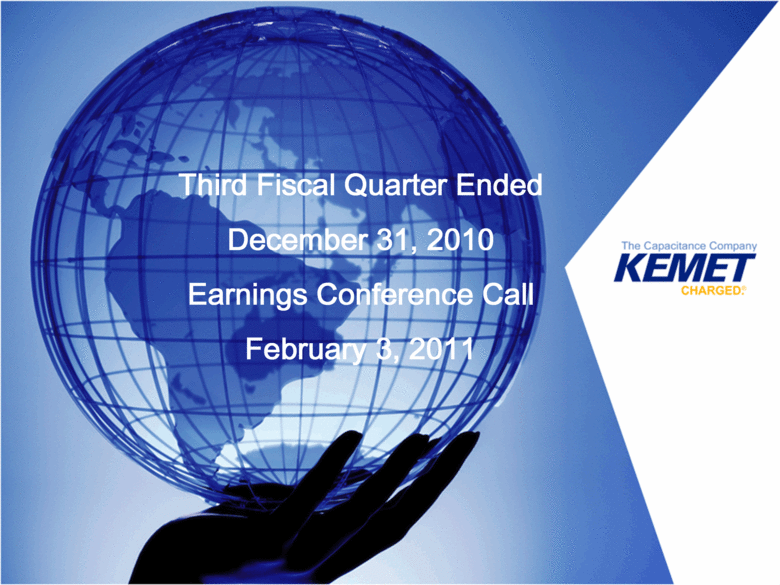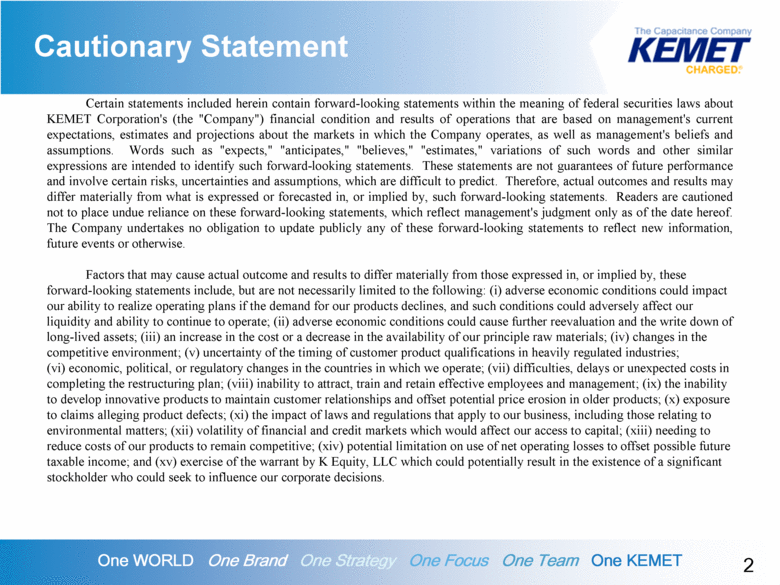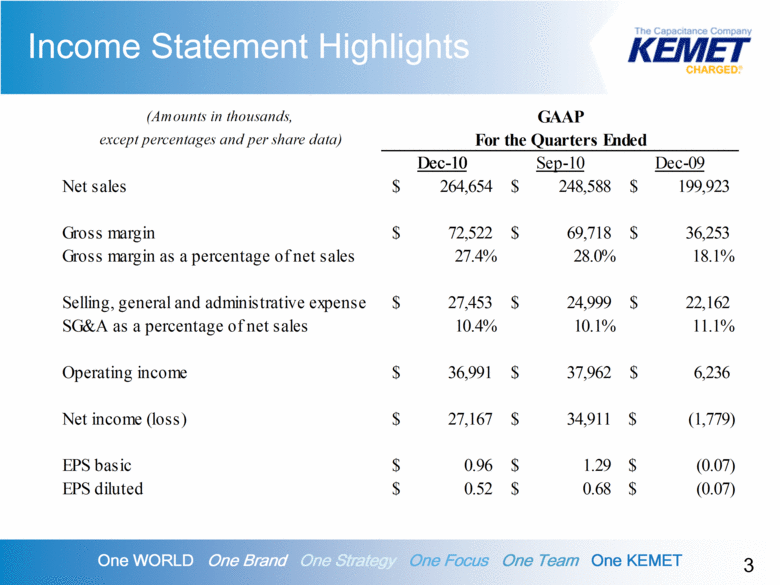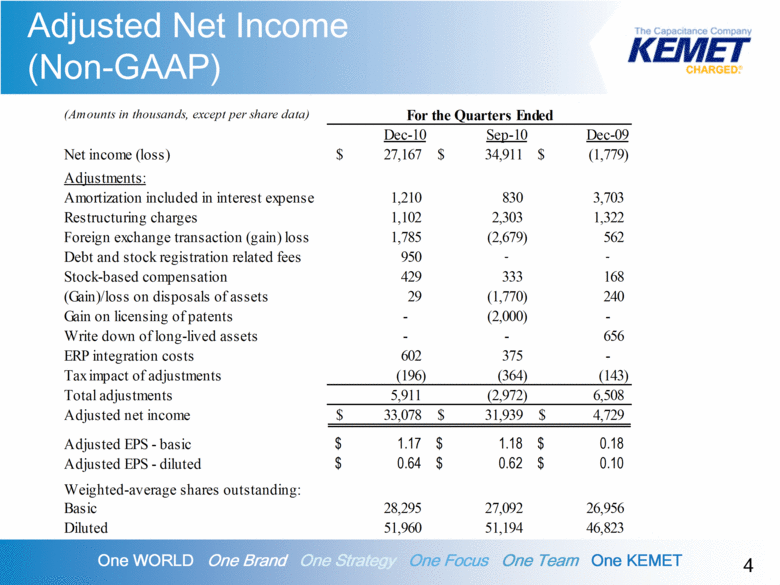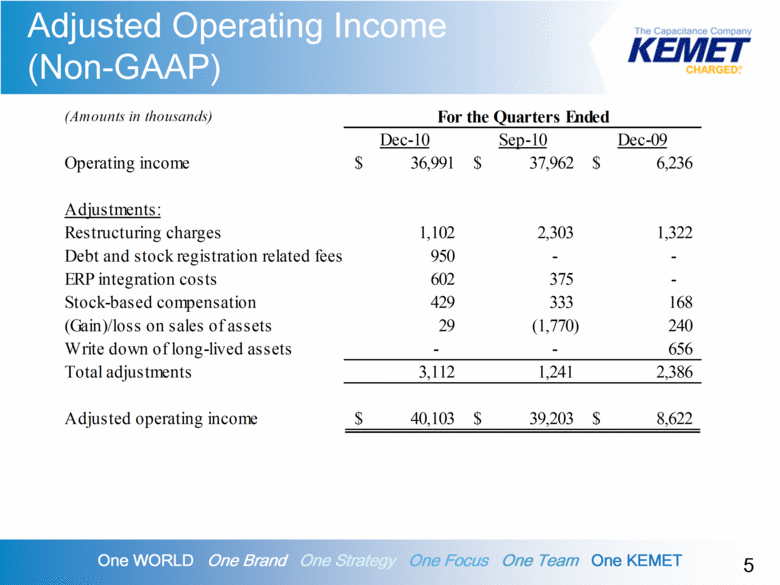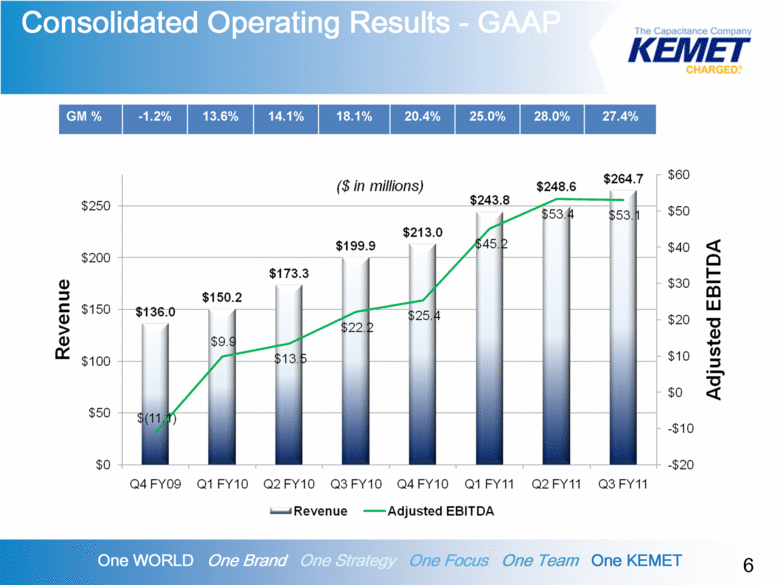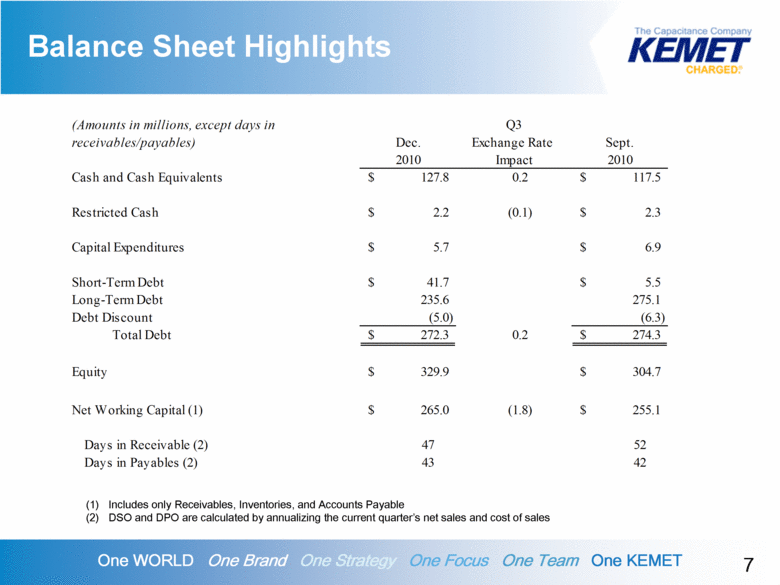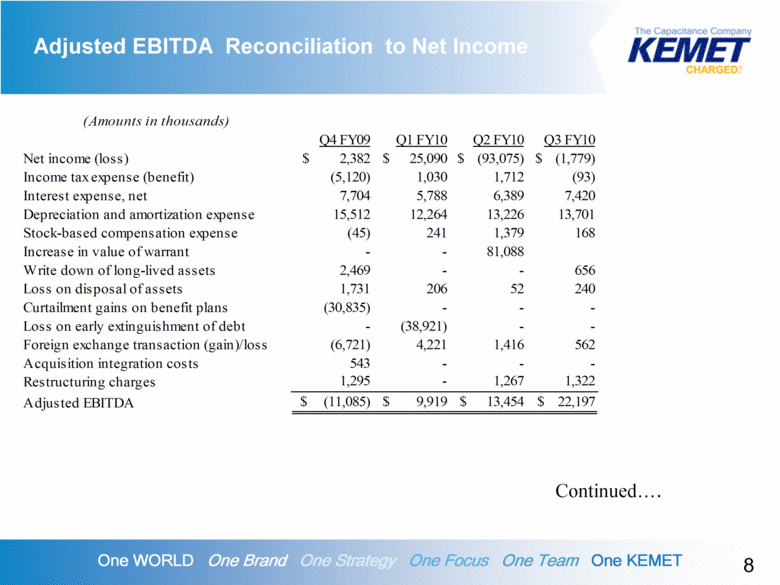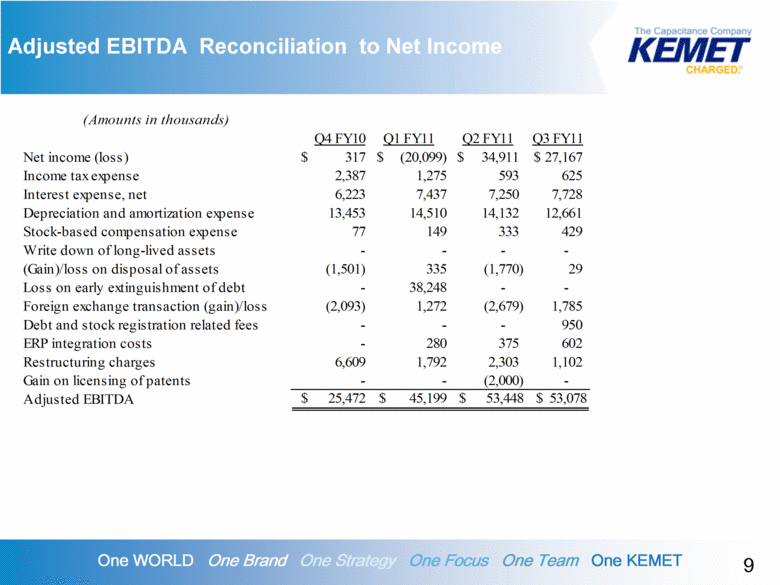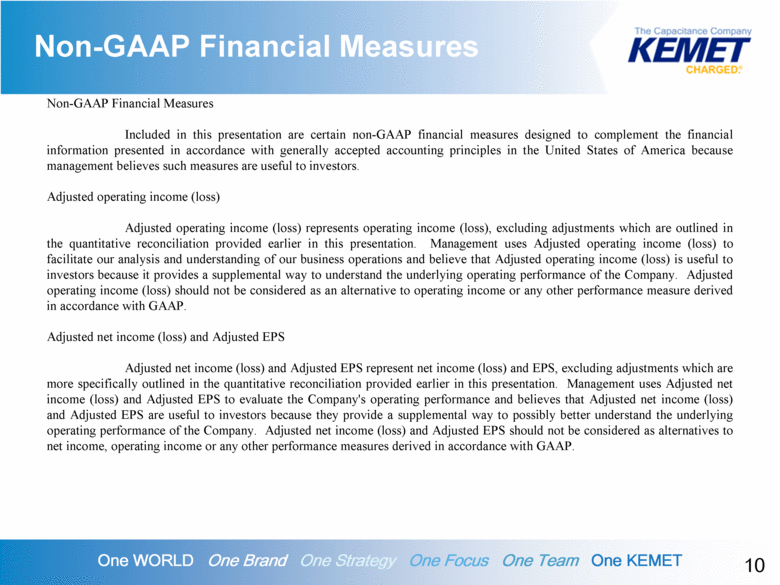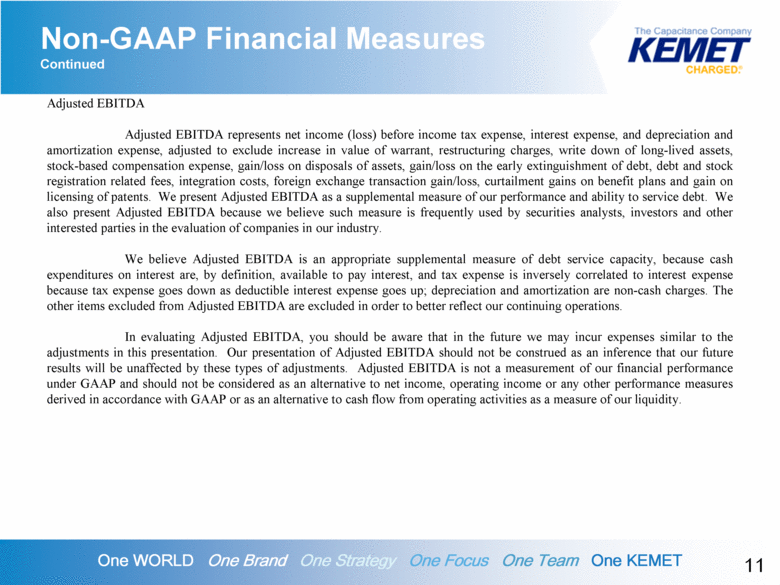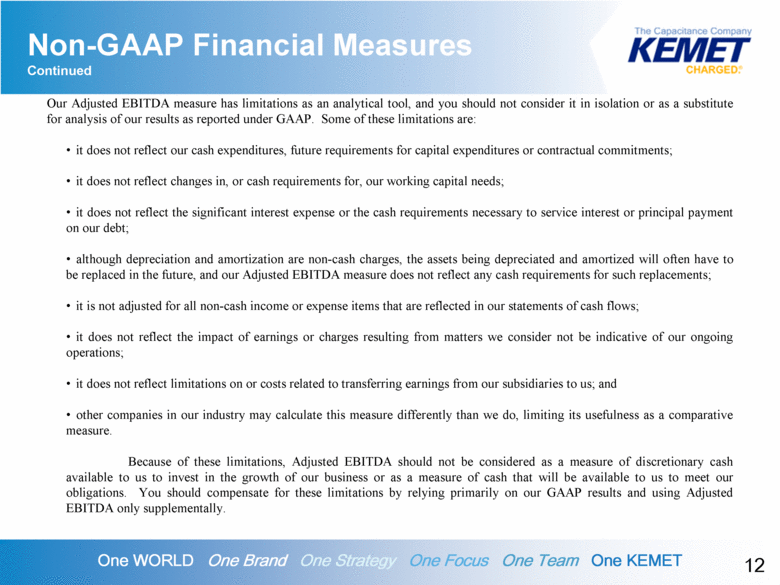Attached files
| file | filename |
|---|---|
| 8-K - 8-K - KEMET CORP | a11-4255_18k.htm |
| EX-99.1 - EX-99.1 - KEMET CORP | a11-4255_1ex99d1.htm |
Exhibit 99.2
|
|
Third Fiscal Quarter Ended December 31, 2010 Earnings Conference Call February 3, 2011 |
|
|
Cautionary Statement 2 Certain statements included herein contain forward-looking statements within the meaning of federal securities laws about KEMET Corporation's (the "Company") financial condition and results of operations that are based on management's current expectations, estimates and projections about the markets in which the Company operates, as well as management's beliefs and assumptions. Words such as "expects," "anticipates," "believes," "estimates," variations of such words and other similar expressions are intended to identify such forward-looking statements. These statements are not guarantees of future performance and involve certain risks, uncertainties and assumptions, which are difficult to predict. Therefore, actual outcomes and results may differ materially from what is expressed or forecasted in, or implied by, such forward-looking statements. Readers are cautioned not to place undue reliance on these forward-looking statements, which reflect management's judgment only as of the date hereof. The Company undertakes no obligation to update publicly any of these forward-looking statements to reflect new information, future events or otherwise. Factors that may cause actual outcome and results to differ materially from those expressed in, or implied by, these forward-looking statements include, but are not necessarily limited to the following: (i) adverse economic conditions could impact our ability to realize operating plans if the demand for our products declines, and such conditions could adversely affect our liquidity and ability to continue to operate; (ii) adverse economic conditions could cause further reevaluation and the write down of long-lived assets; (iii) an increase in the cost or a decrease in the availability of our principle raw materials; (iv) changes in the competitive environment; (v) uncertainty of the timing of customer product qualifications in heavily regulated industries; (vi) economic, political, or regulatory changes in the countries in which we operate; (vii) difficulties, delays or unexpected costs in completing the restructuring plan; (viii) inability to attract, train and retain effective employees and management; (ix) the inability to develop innovative products to maintain customer relationships and offset potential price erosion in older products; (x) exposure to claims alleging product defects; (xi) the impact of laws and regulations that apply to our business, including those relating to environmental matters; (xii) volatility of financial and credit markets which would affect our access to capital; (xiii) needing to reduce costs of our products to remain competitive; (xiv) potential limitation on use of net operating losses to offset possible future taxable income; and (xv) exercise of the warrant by K Equity, LLC which could potentially result in the existence of a significant stockholder who could seek to influence our corporate decisions. |
|
|
3 Income Statement Highlights (Amounts in thousands, GAAP except percentages and per share data) For the Quarters Ended Dec-10 Sep-10 Dec-09 Net sales 264,654 $ 248,588 $ 199,923 $ Gross margin 72,522 $ 69,718 $ 36,253 $ Gross margin as a percentage of net sales 27.4% 28.0% 18.1% Selling, general and administrative expense 27,453 $ 24,999 $ 22,162 $ SG&A as a percentage of net sales 10.4% 10.1% 11.1% Operating income 36,991 $ 37,962 $ 6,236 $ Net income (loss) 27,167 $ 34,911 $ (1,779) $ EPS basic 0.96 $ 1.29 $ (0.07) $ EPS diluted 0.52 $ 0.68 $ (0.07) $ |
|
|
4 Adjusted Net Income (Non-GAAP) (Amounts in thousands, except per share data) For the Quarters Ended Dec-10 Sep-10 Dec-09 Net income (loss) 27,167 $ 34,911 $ (1,779) $ Adjustments: Amortization included in interest expense 1,210 830 3,703 Restructuring charges 1,102 2,303 1,322 Foreign exchange transaction (gain) loss 1,785 (2,679) 562 Debt and stock registration related fees 950 - - Stock-based compensation 429 333 168 (Gain)/loss on disposals of assets 29 (1,770) 240 Gain on licensing of patents - (2,000) - Write down of long-lived assets - - 656 ERP integration costs 602 375 - Tax impact of adjustments (196) (364) (143) Total adjustments 5,911 (2,972) 6,508 Adjusted net income 33,078 $ 31,939 $ 4,729 $ Adjusted EPS - basic 1.17 $ 1.18 $ 0.18 $ Adjusted EPS - diluted 0.64 $ 0.62 $ 0.10 $ Weighted-average shares outstanding: Basic 28,295 27,092 26,956 Diluted 51,960 51,194 46,823 |
|
|
5 Adjusted Operating Income (Non-GAAP) (Amounts in thousands) For the Quarters Ended Dec-10 Sep-10 Dec-09 Operating income 36,991 $ 37,962 $ 6,236 $ Adjustments: Restructuring charges 1,102 2,303 1,322 Debt and stock registration related fees 950 - - ERP integration costs 602 375 - Stock-based compensation 429 333 168 (Gain)/loss on sales of assets 29 (1,770) 240 Write down of long-lived assets - - 656 Total adjustments 3,112 1,241 2,386 Adjusted operating income 40,103 $ 39,203 $ 8,622 $ |
|
|
GM % -1.2% 13.6% 14.1% 18.1% 20.4% 25.0% 28.0% 27.4% Consolidated Operating Results - GAAP 6 |
|
|
Balance Sheet Highlights (1) Includes only Receivables, Inventories, and Accounts Payable (2) DSO and DPO are calculated by annualizing the current quarter’s net sales and cost of sales 7 (Amounts in millions, except days in receivables/payables) Cash and Cash Equivalents Restricted Cash Capital Expenditures Short-Term Debt Long-Term Debt Debt Discount Total Debt Equity Net Working Capital (1) Days in Receivable (2) Days in Payables (2) 43 42 265.0 $ (1.8) 255.1 $ 47 52 329.9 $ 304.7 $ (5.0) (6.3) 272.3 $ 0.2 274.3 $ 41.7 $ 5.5 $ 235.6 275.1 5.7 $ 6.9 $ 2.2 $ (0.1) 2.3 $ 2010 Impact 2010 127.8 $ 0.2 117.5 $ Q3 Dec. Exchange Rate Sept. |
|
|
Adjusted EBITDA Reconciliation to Net Income 8 Continued. (Amounts in thousands) Q4 FY09 Q1 FY10 Q2 FY10 Q3 FY10 Net income (loss) $ 2,382 $ 25,090 $ (93,075) $ (1,779) Income tax expense (benefit) (5,120) 1,030 1,712 (93) Interest expense, net 7,704 5,788 6,389 7,420 Depreciation and amortization expense 15,512 12,264 13,226 13,701 Stock-based compensation expense (45) 241 1,379 168 Increase in value of warrant - - 81,088 Write down of long-lived assets 2,469 - - 656 Loss on disposal of assets 1,731 206 52 240 Curtailment gains on benefit plans (30,835) - - - Loss on early extinguishment of debt - (38,921) - - Foreign exchange transaction (gain)/loss (6,721) 4,221 1,416 562 Acquisition integration costs 543 - - - Restructuring charges 1,295 - 1,267 1,322 Adjusted EBITDA $ (11,085) $ 9,919 $ 13,454 $ 22,197 |
|
|
Adjusted EBITDA Reconciliation to Net Income 9 (Amounts in thousands) Q4 FY10 Q1 FY11 Q2 FY11 Q3 FY11 Net income (loss) $ 317 $ (20,099) 34,911 $ 27,167 $ Income tax expense 2,387 1,275 593 625 Interest expense, net 6,223 7,437 7,250 7,728 Depreciation and amortization expense 13,453 14,510 14,132 12,661 Stock-based compensation expense 77 149 333 429 Write down of long-lived assets - - - - (Gain)/loss on disposal of assets (1,501) 335 (1,770) 29 Loss on early extinguishment of debt - 38,248 - - Foreign exchange transaction (gain)/loss (2,093) 1,272 (2,679) 1,785 Debt and stock registration related fees - - - 950 ERP integration costs - 280 375 602 Restructuring charges 6,609 1,792 2,303 1,102 Gain on licensing of patents - - (2,000) - Adjusted EBITDA $ 25,472 $ 45,199 $ 53,448 $ 53,078 |
|
|
Non-GAAP Financial Measures 10 Non-GAAP Financial Measures Included in this presentation are certain non-GAAP financial measures designed to complement the financial information presented in accordance with generally accepted accounting principles in the United States of America because management believes such measures are useful to investors. Adjusted operating income (loss) Adjusted operating income (loss) represents operating income (loss), excluding adjustments which are outlined in the quantitative reconciliation provided earlier in this presentation. Management uses Adjusted operating income (loss) to facilitate our analysis and understanding of our business operations and believe that Adjusted operating income (loss) is useful to investors because it provides a supplemental way to understand the underlying operating performance of the Company. Adjusted operating income (loss) should not be considered as an alternative to operating income or any other performance measure derived in accordance with GAAP. Adjusted net income (loss) and Adjusted EPS Adjusted net income (loss) and Adjusted EPS represent net income (loss) and EPS, excluding adjustments which are more specifically outlined in the quantitative reconciliation provided earlier in this presentation. Management uses Adjusted net income (loss) and Adjusted EPS to evaluate the Company's operating performance and believes that Adjusted net income (loss) and Adjusted EPS are useful to investors because they provide a supplemental way to possibly better understand the underlying operating performance of the Company. Adjusted net income (loss) and Adjusted EPS should not be considered as alternatives to net income, operating income or any other performance measures derived in accordance with GAAP. |
|
|
Non-GAAP Financial Measures Continued 11 Adjusted EBITDA Adjusted EBITDA represents net income (loss) before income tax expense, interest expense, and depreciation and amortization expense, adjusted to exclude increase in value of warrant, restructuring charges, write down of long-lived assets, stock-based compensation expense, gain/loss on disposals of assets, gain/loss on the early extinguishment of debt, debt and stock registration related fees, integration costs, foreign exchange transaction gain/loss, curtailment gains on benefit plans and gain on licensing of patents. We present Adjusted EBITDA as a supplemental measure of our performance and ability to service debt. We also present Adjusted EBITDA because we believe such measure is frequently used by securities analysts, investors and other interested parties in the evaluation of companies in our industry. We believe Adjusted EBITDA is an appropriate supplemental measure of debt service capacity, because cash expenditures on interest are, by definition, available to pay interest, and tax expense is inversely correlated to interest expense because tax expense goes down as deductible interest expense goes up; depreciation and amortization are non-cash charges. The other items excluded from Adjusted EBITDA are excluded in order to better reflect our continuing operations. In evaluating Adjusted EBITDA, you should be aware that in the future we may incur expenses similar to the adjustments in this presentation. Our presentation of Adjusted EBITDA should not be construed as an inference that our future results will be unaffected by these types of adjustments. Adjusted EBITDA is not a measurement of our financial performance under GAAP and should not be considered as an alternative to net income, operating income or any other performance measures derived in accordance with GAAP or as an alternative to cash flow from operating activities as a measure of our liquidity. |
|
|
Non-GAAP Financial Measures Continued 12 Our Adjusted EBITDA measure has limitations as an analytical tool, and you should not consider it in isolation or as a substitute for analysis of our results as reported under GAAP. Some of these limitations are: it does not reflect our cash expenditures, future requirements for capital expenditures or contractual commitments; it does not reflect changes in, or cash requirements for, our working capital needs; it does not reflect the significant interest expense or the cash requirements necessary to service interest or principal payment on our debt; although depreciation and amortization are non-cash charges, the assets being depreciated and amortized will often have to be replaced in the future, and our Adjusted EBITDA measure does not reflect any cash requirements for such replacements; it is not adjusted for all non-cash income or expense items that are reflected in our statements of cash flows; it does not reflect the impact of earnings or charges resulting from matters we consider not be indicative of our ongoing operations; it does not reflect limitations on or costs related to transferring earnings from our subsidiaries to us; and other companies in our industry may calculate this measure differently than we do, limiting its usefulness as a comparative measure. Because of these limitations, Adjusted EBITDA should not be considered as a measure of discretionary cash available to us to invest in the growth of our business or as a measure of cash that will be available to us to meet our obligations. You should compensate for these limitations by relying primarily on our GAAP results and using Adjusted EBITDA only supplementally. |

